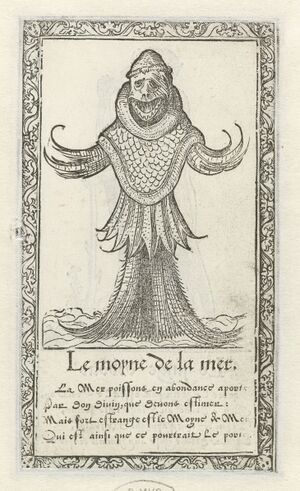Mermonk: Difference between revisions
From Marinelexicon
No edit summary |
No edit summary |
||
| Line 1: | Line 1: | ||
<gallery mode=packed heights=30px class=center> | <gallery mode=packed heights=30px class=center> | ||
PT.jpg|<small>Português</small>|link=https://wiki. | PT.jpg|<small>Português</small>|link=https://wiki.uib.no/lexicomarinho/index.php/Monge_marinho | ||
NO.jpg|<small>Norsk</small>|link=https://wiki.uib.no/marinleksikon/index.php/Havmunk | NO.jpg|<small>Norsk</small>|link=https://wiki.uib.no/marinleksikon/index.php/Havmunk | ||
</gallery> | </gallery> | ||
Revision as of 08:06, 12 May 2021
-
Português
-
Norsk
Marine Lexicon — Marine mammals — Mythical creatures — Activities related to marine mammals — Toponomy — Zooarchaeology — Historical sources — Cite Marine Lexicon


mermonk • Nordic creature that is mentioned by the Swiss naturalist Conrad Gesner in his chapter on merpeople[1]. Apparently, a mermonk was captured by herring fishers in the Baltic Sea near Copenhagen. Gesner also mentions a merbishop that was captured near Poland in 1531.
- English
- Mermonk
- Portuguese
- Monge marinho
- Norwegian
- Havmunk (literal translation; not known in Norwegian mythology)
- Dutch
- Zeemonnik (literal translation; not known in Dutch mythology)
- German
- Seemönch
- French
- Moine de mer; Poisson-moine
- Spanish
- Italian
- Greek
- Creole
References
- ↑ Conrad Gesner, 1604: Historiae animalium, p. 439.

